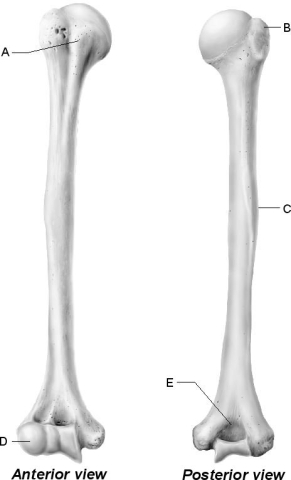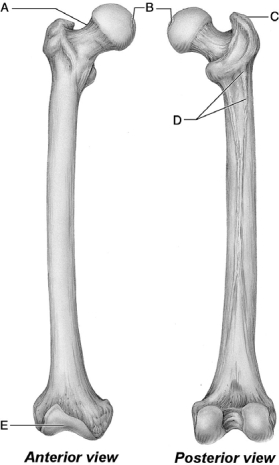Correct Answer

verified
Correct Answer
verified
Multiple Choice
Which of the following statements about the patella is false?
A) It articulates with the femur, tibia, and fibula.
B) It acts to protect the knee joint anteriorly.
C) It is roughly triangular in shape.
D) It is a sesamoid bone.
Correct Answer

verified
Correct Answer
verified
Multiple Choice
The supraspinous fossa is in the region of the scapula.
A) anterosuperior
B) posteroinferior
C) anteroinferior
D) posterosuperior
Correct Answer

verified
Correct Answer
verified
Multiple Choice
 Figure 8.3
Use the diagram above to answer the following questions.
-Which letter indicates the fossa where the ulna articulates with the humerus?
Figure 8.3
Use the diagram above to answer the following questions.
-Which letter indicates the fossa where the ulna articulates with the humerus?
A) A
B) B
C) C
D) D
E) E
Correct Answer

verified
Correct Answer
verified
Multiple Choice
All of these statements regarding the acetabulum are true except
A) The acetabulum is cup-shaped.
B) The acetabulum participates in the hip joint.
C) The acetabulum is where the three pelvic bones intersect.
D) The acetabulum articulates with the sacrum.
Correct Answer

verified
Correct Answer
verified
Multiple Choice
As it runs from the hip to the knee, the femur projects as well as inferiorly.
A) medially
B) laterally
C) anteriorly
D) posteriorly
Correct Answer

verified
Correct Answer
verified
Short Answer
An interosseous membrane is found between the tibia and the in the lower extremity.
Correct Answer

verified
Correct Answer
verified
Multiple Choice
The bony landmark at the lateral angle of the scapula is the
A) spine.
B) acromion.
C) glenoid cavity.
D) suprascapular notch.
Correct Answer

verified
Correct Answer
verified
Multiple Choice
All of these bones are in the proximal row of four carpal bones except the
A) trapezoid.
B) pisiform.
C) triquetral.
D) scaphoid.
Correct Answer

verified
Correct Answer
verified
True/False
The tibia articulates distally with the trochlea of the talus.
Correct Answer

verified
Correct Answer
verified
Multiple Choice
Which of the statements below regarding the metatarsals is false?
A) They contribute to the three arches of the feet.
B) They are numbered 1-5 from lateral to medial, just like the metacarpals.
C) They articulate proximally to the cuneiforms and cuboid.
D) They support some of the bodyʹs weight.
Correct Answer

verified
Correct Answer
verified
Multiple Choice
 Figure 8.2
Use the diagram above to answer the following questions.
-Which letter indicates the groove that articulates with the patella?
Figure 8.2
Use the diagram above to answer the following questions.
-Which letter indicates the groove that articulates with the patella?
A) A
B) B
C) C
D) D
E) E
Correct Answer

verified
Correct Answer
verified
Multiple Choice
The bony landmark which is the attachment point for the patellar ligament is found on which of the bones listed below?
A) radius
B) tibia
C) ulna
D) humerus
Correct Answer

verified
Correct Answer
verified
Multiple Choice
The fibula has all of the following features except the
A) inferior tibiofibular joint (facet) .
B) medial malleolus.
C) head.
D) lateral malleolus.
Correct Answer

verified
Correct Answer
verified
Multiple Choice
The coronoid process is part of the
A) humerus.
B) carpal bones.
C) ulna.
D) radius.
Correct Answer

verified
Correct Answer
verified
Multiple Choice
The ulnar notch is found on which of the bones listed below?
A) radius
B) tibia
C) ulna
D) humerus
Correct Answer

verified
Correct Answer
verified
Multiple Choice
The auricular surface of the ilium
A) forms the lateral borders of the false pelvis.
B) attaches gluteal muscles.
C) forms the sacroiliac joint.
D) lines the interior of the acetabulum.
Correct Answer

verified
Correct Answer
verified
Multiple Choice
The clavicle functions to
A) protect the lungs.
B) allow the arm to extend further for reaching.
C) provide balance for the scapula on the other side of the body.
D) transmit compression forces from the upper limb to the axial skeleton.
Correct Answer

verified
Correct Answer
verified
True/False
The proximal end of the fibula is the lateral malleolus.
Correct Answer

verified
Correct Answer
verified
Multiple Choice
The deltoid tuberosity is found on which of the bones listed below?
A) radius
B) tibia
C) ulna
D) humerus
Correct Answer

verified
Correct Answer
verified
Showing 81 - 100 of 110
Related Exams